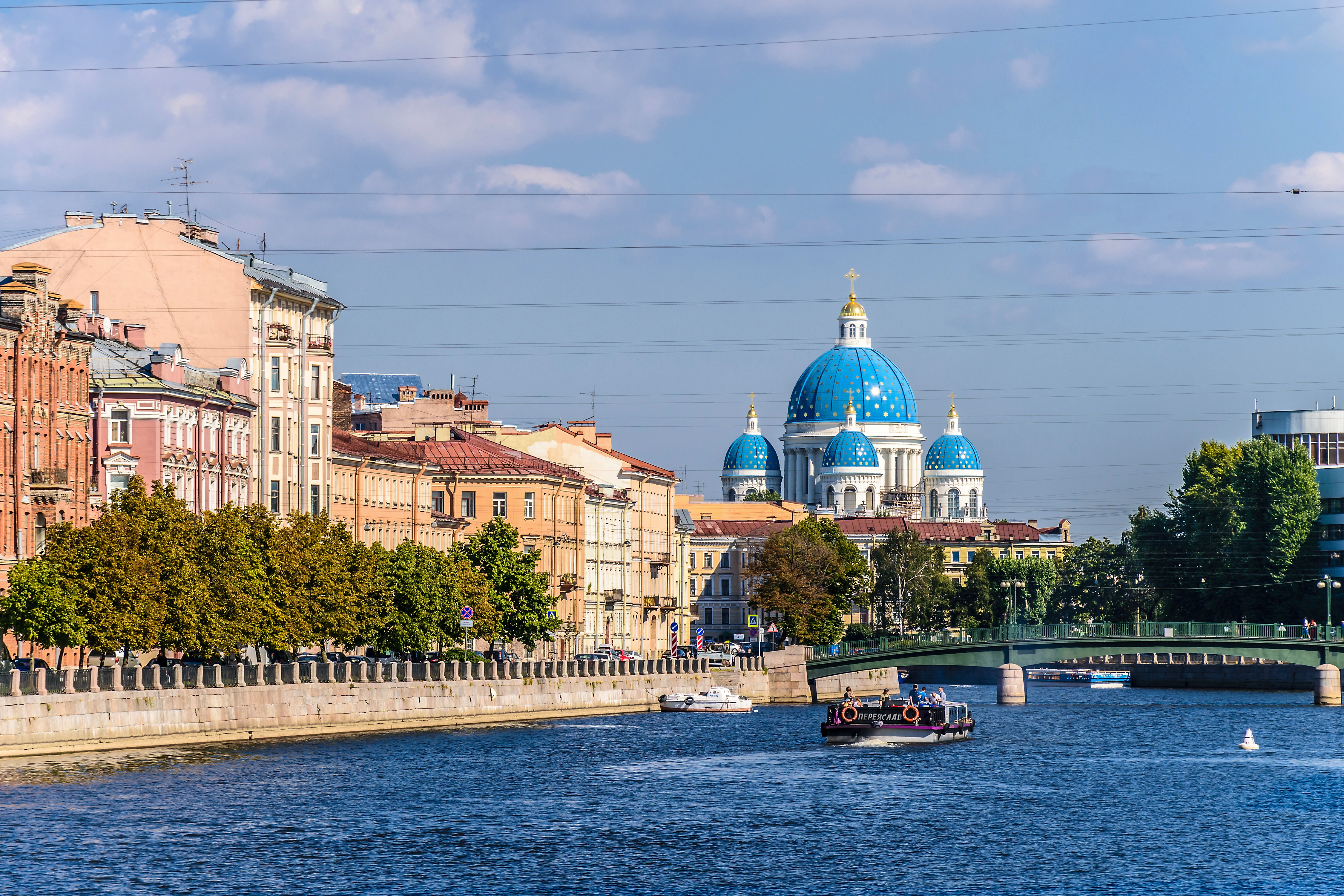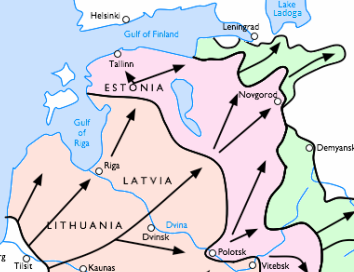|
Mogilyovsky Bridge
Mogilyovsky Bridge is a bridge across the Griboyedov Canal to Admiralteysky District of Saint Petersburg that connects Kolomensky and Pokrovsky Islands. This bridge is located along the Lermontovsky Avenue axis. It is near the Estonian Orthodox Brotherhood St. Isidor's Church which was built in 1903—1907 by architect Alexander Poleshchuk. Upstream from Mogilyovsky Bridge is Pikalov Bridge; below is Alarchin Bridge. The closest metro station is 1.6 км away and is called Sadovaya. Name The bridge's name has been known since 1906 and used along Mogilyovskaya Street, at the section of the current Lermontovsky Prospekt between the Ekaterininsky Canal and Fontanka. Initially, the name "Mogilev pedestrian bridge" was used, but after its reconstruction in 1912, the bridge became a transport bridge and the name "pedestrian" was dropped. History In 1905–1906 according to engineer P.A. Likhachev's project and under his supervision, a pedestrian wooden bridge was built. In 1911— ... [...More Info...] [...Related Items...] OR: [Wikipedia] [Google] [Baidu] |
Admiralteysky District
Admiralteysky District () is a district of the federal city of St. Petersburg, Russia. As of the 2010 Census, its population: was 157,897; down from 187,837 recorded in the 2002 Census. Geography The district borders the Neva River in the north and in the west, the Yekateringofka River in the southwest, areas around Gorokhovaya Street in the east, and areas around Zagorodny Avenue in the south. History It was established on March 11, 1994 as a result of the merger of Leninsky and Oktyabrsky Districts.Official website of the Administration of St. PetersburgAdmiralteysky District. General Information. Municipal divisions Admiralteysky District comprises the following six municipal okrugs:Law #411-68 * Admiralteysky * Izmaylovskoye *Kolomna Kolomna (, ) is a historic types of inhabited localities in Russia, city in Moscow Oblast, Russia, situated at the confluence of the Moskva River, Moskva and Oka Rivers, (by rail) southeast of Moscow. Popula ... [...More Info...] [...Related Items...] OR: [Wikipedia] [Google] [Baidu] |
Griboyedov Canal
The Griboyedov Canal or Kanal Griboyedova () is a canal in Saint Petersburg, constructed in 1739 along the existing ''Krivusha'' river. In 1764–90, the canal was deepened and the banks were reinforced and covered with granite. The Griboyedov Canal starts from the Moyka River near the Field of Mars (Saint Petersburg), Field of Mars. It flows into the Fontanka River. Its length is , with a width of . Before 1923, it was called the Catherine Canal, after the Empress Catherine II of Russia, Catherine the Great, during whose rule it was deepened. The Communist authorities renamed it after the Russian playwright and diplomat, Alexandr Griboyedov. The streets or embankments running along the canal are known as ''Naberezhnaya Kanala Griboyedova''. Bridges There are 21 bridges across the canal: * Tripartite Bridge * Novo-Konyushenny Bridge * Italian Bridge * Kazansky Bridge * Bank Bridge * Flour Bridge * Stone Bridge (Saint Petersburg), Stone Bridge * Demidov Bridge * Sennoy ... [...More Info...] [...Related Items...] OR: [Wikipedia] [Google] [Baidu] |
Saint Petersburg
Saint Petersburg, formerly known as Petrograd and later Leningrad, is the List of cities and towns in Russia by population, second-largest city in Russia after Moscow. It is situated on the Neva, River Neva, at the head of the Gulf of Finland on the Baltic Sea. The city had a population of 5,601,911 residents as of 2021, with more than 6.4 million people living in the Saint Petersburg metropolitan area, metropolitan area. Saint Petersburg is the List of European cities by population within city limits, fourth-most populous city in Europe, the List of cities and towns around the Baltic Sea, most populous city on the Baltic Sea, and the world's List of northernmost items#Cities and settlements, northernmost city of more than 1 million residents. As the former capital of the Russian Empire, and a Ports of the Baltic Sea, historically strategic port, it is governed as a Federal cities of Russia, federal city. The city was founded by Tsar Peter the Great on 27 May 1703 on the s ... [...More Info...] [...Related Items...] OR: [Wikipedia] [Google] [Baidu] |
Sadovaya (Saint Petersburg Metro)
Sadovaya () is a station on the Frunzensko-Primorskaya Line of Saint Petersburg Metro, opened on 30 December 1991. It provides a transfer to the Pravoberezhnaya line through Spasskaya and the Moskovsko-Petrogradskaya line Line 2 of the Saint Petersburg Metro, also known as ''Moskovsko-Petrogradskaya Line'' () or ''Blue Line'', is a second oldest rapid transit line in Saint Petersburg, Russia, opened in 1961, which connects city centre with the northern and southe ... through Sennaya Ploshchad. Transport Buses: 49, 50, 70, 71, 181, 262. Trams: 3. Saint Petersburg Metro stations Railway stations in Russia opened in 1991 Railway stations located underground in Russia {{Russia-railstation-stub ... [...More Info...] [...Related Items...] OR: [Wikipedia] [Google] [Baidu] |
Fontanka
The Fontanka (), a left branch of the river Neva, flows through the whole of Central Saint Petersburg, Russia – from the Summer Garden to . It is long, with a width up to , and a depth up to . The Moyka River forms a right-bank branch of the Fontanka. Lined along the Fontanka Embankment stand the former private residences of Russian nobility. Description The river, one of 93 rivers and channels in Saint Petersburg, was once named ''Anonymous Creek'' (in Russian, ''Bezymyannyi Yerik'', ''Безымянный ерик''). In Russian, ''yerik'' is a secondary or intermittent river-channel ( creek or brook). In 1719 the river received its present name, because water from it supplied the fountains of the Summer Garden. Until the mid-18th century the Fontanka River marked the southern boundary of Saint Petersburg. Along its banks stood the spacious messuages of members of the Russian Imperial Family and of the nobility, the most brilliant being the Summer Palace ... [...More Info...] [...Related Items...] OR: [Wikipedia] [Google] [Baidu] |
Siege Of Leningrad
The siege of Leningrad was a Siege, military blockade undertaken by the Axis powers against the city of Leningrad (present-day Saint Petersburg) in the Soviet Union on the Eastern Front (World War II), Eastern Front of World War II from 1941 to 1944. Leningrad, the country's second largest city, was besieged by Nazi Germany, Germany and Finland for 872 days, but never captured. The siege was the List of sieges, most destructive in history and possibly the List of battles by casualties#Sieges and urban combat, most deadly, causing an estimated 1.5 million deaths, from a prewar population of 3.2 million. It was not classified as a war crime at the time, but some historians have since classified it as a genocide due to the intentional destruction of the city and the systematic starvation of its civilian population. p. 334 In August 1941, Nazi Germany, Germany's Army Group North reached the suburbs of Leningrad as Finnish forces moved to encircle the city from the north. Land ... [...More Info...] [...Related Items...] OR: [Wikipedia] [Google] [Baidu] |
Bridges In Saint Petersburg
There are more than 400 bridges in the city limits of Saint Petersburg, Russia. This is a partial list of the most famous ones. Peter the Great was designing the city as another Amsterdam and Venice, with canals instead of streets and citizens skillful in sailing. Initially, there were only about ten bridges constructed in the city, mainly across ditches and minor creeks. By Peter's plans, in the summer months, the citizens were supposed to move around in boats, and in the winter months when the water froze to move in sledges. However, after Peter's death, new bridges were built, as it was a much easier way of transportation. Temporary ponton bridges were used in the summertime. The first permanent bridge of bricks and stones across the main branch of the Neva river appeared in 1850. Today, there are more 342 bridges over canals and rivers of various sizes, styles and constructions, built at different periods. Some of them are small pedestrian bridges, such as Bank and Lion bridge ... [...More Info...] [...Related Items...] OR: [Wikipedia] [Google] [Baidu] |
Arch Bridges In Russia
An arch is a curved vertical structure spanning an open space underneath it. Arches may support the load above them, or they may perform a purely decorative role. As a decorative element, the arch dates back to the 4th millennium BC, but structural load-bearing arches became popular only after their adoption by the Ancient Romans in the 4th century BC. Arch-like structures can be horizontal, like an arch dam that withstands the horizontal hydrostatic pressure load. Arches are usually used as supports for many types of vaults, with the barrel vault in particular being a continuous arch. Extensive use of arches and vaults characterizes an arcuated construction, as opposed to the trabeated system, where, like in the architectures of ancient Greece, China, and Japan (as well as the modern steel-framed technique), posts and beams dominate. Arches had several advantages over the lintel, especially in the masonry construction: with the same amount of material it can have larger ... [...More Info...] [...Related Items...] OR: [Wikipedia] [Google] [Baidu] |


